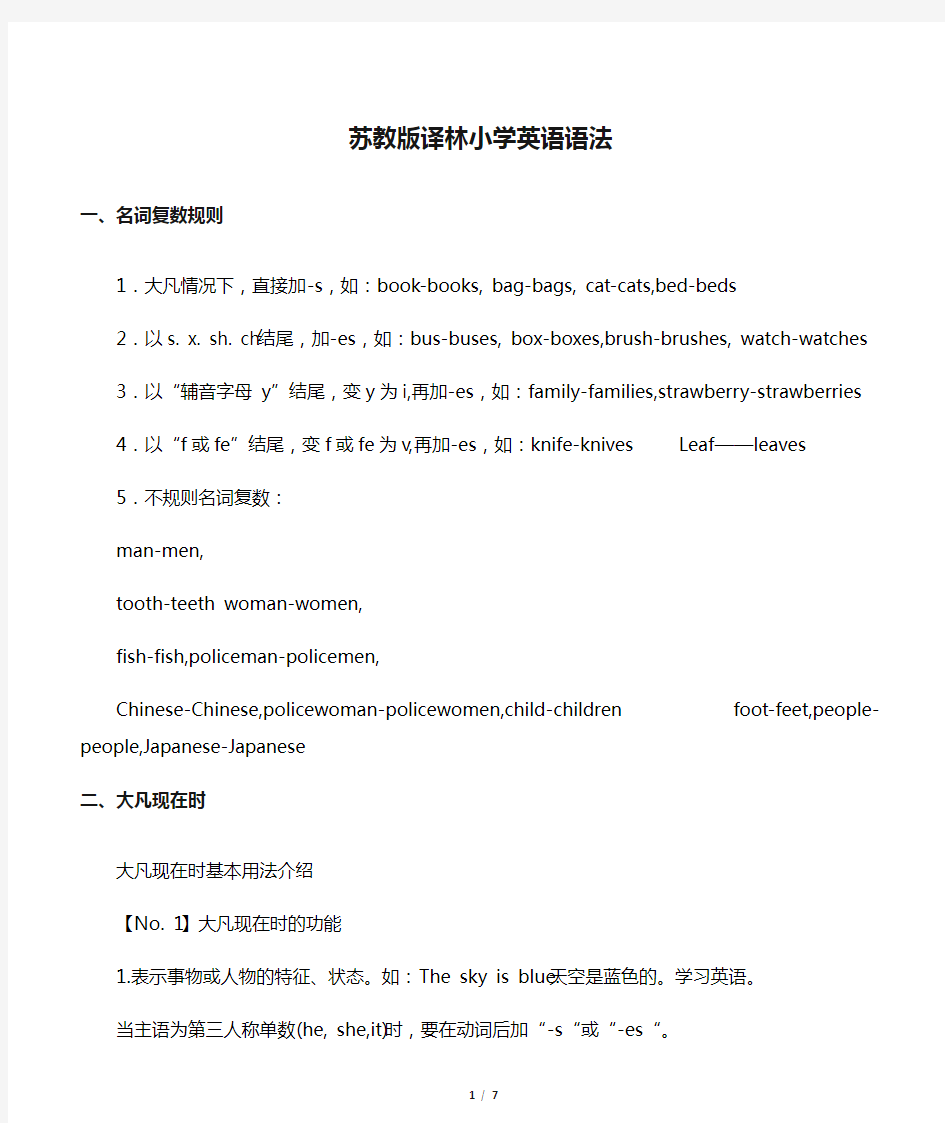(完整版)苏教版译林小学英语语法

- 1、下载文档前请自行甄别文档内容的完整性,平台不提供额外的编辑、内容补充、找答案等附加服务。
- 2、"仅部分预览"的文档,不可在线预览部分如存在完整性等问题,可反馈申请退款(可完整预览的文档不适用该条件!)。
- 3、如文档侵犯您的权益,请联系客服反馈,我们会尽快为您处理(人工客服工作时间:9:00-18:30)。
苏教版译林小学英语语法
一、名词复数规则
1.大凡情况下,直接加-s,如:book-books, bag-bags, cat-cats,bed-beds
2.以s. x. sh. ch结尾,加-es,如:bus-buses, box-boxes,brush-brushes, watch-watches
3.以“辅音字母y”结尾,变y为i,再加-es,如:family-families,strawberry-strawberries
4.以“f或fe”结尾,变f或fe为v,再加-es,如:knife-knives Leaf——leaves
5.不规则名词复数:
man-men,
tooth-teeth woman-women,
fish-fish,policeman-policemen,
Chinese-Chinese,policewoman-policewomen,child-children foot-feet,people-people,Japanese-Japanese
二、大凡现在时
大凡现在时基本用法介绍
【No. 1】大凡现在时的功能
1.表示事物或人物的特征、状态。如:The sky is blue.天空是蓝色的。学习英语。
当主语为第三人称单数(he, she,it)时,要在动词后加“-s“或“-es“。
如:Mary likes Chinese.玛丽喜欢汉语。
【No. 2】大凡现在时的变化
1. be动词的变化。
否定句:主语be not 其它。如:He is not a worker.他不是工人。
大凡疑问句:Be 主语其它。
如:-Are you a student?
-Yes. I am. / No, I“m not.
非凡疑问句:疑问词大凡疑问句。如:Where is my bike?
2.行为动词的变化。
否定句:主语don“t(doesn“t )动词原形(其它)。如:I don“t like bread.
当主语为第三人称单数时,要用doesn“t构成否定句。如:He doesn“t often play.
大凡疑问句:Do( Does )主语动词原形其它。如:- Do you often play football?
- Yes, I do. / No, I don“t.
当主语为第三人称单数时,要用does构成大凡疑问句。如:- Does she go to work by bike?
- Yes, she does. / No, she doesn“t.
3.动词s的变化规则2.现在进行时的肯定句基本结构为be 动词ing.3.现在进行时的否定句在be后加not。
4.现在进行时的大凡疑问句把be动词调到句首。
5.现在进行时的非凡疑问的基本结构为:疑问词不达意be 主语动词ing?
但疑问词当主语时其结构为:疑问词不达意be 动词ing?动词加ing的变化规则
1.大凡情况下,直接加ing,如:cook-cooking 2.以不发音的e结尾,去e加ing,如:make-making,taste-tasting 3.假如末尾是一个元音字母和一个辅音字母,双写末尾的辅音字母,再加ing,如:run-running, stop-stopping
四、将来时理论及练习
1、概念:表示将要发生的动作或存在的状态及打算、计划或预备做某事。句中大凡有以下时间状语:tomorrow,next day(week,month,year…),soon, the day after tomorrow(后天)等。
2、基本结构:①be going to do;②will do.
3、否定句:在be动词(am, is, are)l后加not或情态动词will后加not成won’t。
例如:I’m going to have a picnic this afternoon.→ I’m not going to have a picnic this afternoon.
4、同义句:be going to = will
I am going to go swimming tomorrow(明天).=I will go swimming tomorrow.3.句中没有be动词的大凡过去时的句子
否定句:didn’t 动词原形,如:Jim didn’t go home yesterday.
4.动词过去式变化规则:
1.大凡在动词末尾加-ed,如:work__-worked , cook-cooked 2.结尾是e
加d,如:live____lived
3.末尾只有一个元音字母和一个辅音字母的重读闭音节,应双写末尾的辅音字母,再加-ed,如:stop-stopped
4.以“辅音字母y”结尾的,变y为i,再加-ed,如:study-studied 5.不规则动词过去式:am,is-was,are-were,do-did,see-saw,say-said,give-gave,get-got,go-went,come-came,have-had,eat-ate,take-took,run-ran,sing-sang,put-put,make-made,read-read,write-wrote,draw-drew,drink-drank,swim-swam,sit-sat
六、人称代词和物主代词
主格宾格形容词性名词性
I me my mine
you you your yours
he him his his
she her her hers
it it its its
we us our ours
七、详尽用法
1.Hello的用法
Hello 的意思为“您好”,大凡可作为熟人,亲朋好友之间的打招呼回答时,可用My name is ….来回答,接着反问对方时,可用And what“s your name?来提问。例如:
Hi!What“s your name?你好,你叫什么名字?Hi!My name is Lucy.And what“s your name?你好,我叫露西。
你叫什么名字?
My name is Wang Ying.我叫王英。
句中的What“s是What is的缩写形式。
3.Good morning,class (teacher).的用法Good morning,class.同学们好。Good morning,teacher.老师好。
这是上午上课时,老师和全班同学互相问候时用语。Good morning 是上午问候时的用语,多用于熟人,朋友或家人之间,是比较正式的问候用语。句中问候语放在前面,称呼语则要放在后面,并用逗号隔开。例如:Good morning.Mr.White.怀特先生,你好。
